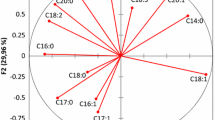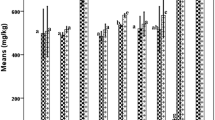Abstract
Phenolics, volatiles, squalene, tocopherols, and fatty acids of virgin olive oils (VOO) from adult and young olive trees of the Oueslati variety, typically cultivated in the Center of Tunisia, were analyzed at three different harvesting periods. Significant differences in contents of saturated fatty acids (p < 0.05), squalene (p < 0.05), alpha-tocopherol and total tocopherol (p < 0.02) and oxidized form of decarboxymethyl oleuropein aglycon (p < 0.05) were seen between VOO from adult and young trees during maturation. Moreover, the volatile profiles of VOO from adult and young trees showed significant differences in the amounts of hexanal, 1-penten-3-ol (p < 0.05), (Z)-3-hexenal and (Z)-2-penten-1-ol (p < 0.01). Principal component analysis showed that olives from adult trees should be harvested at the cherry stage of maturation to obtain a satisfactory level of oil quality, while olives from young trees should be harvested at the black maturation stage.




Similar content being viewed by others
Abbreviations
- VOO:
-
Virgin olive oils
- EVOO:
-
Extra virgin olive oils
- MI:
-
Maturation index
- SFA:
-
Saturated fatty acid(s)
- MUFA:
-
Monounsaturated fatty acid(s)
- PUFA:
-
Polyunsaturated fatty acid(s)
- OxDOA:
-
Decarboxymethyl oleuropein aglycon oxidised form
- DOA:
-
Decarboxymethyl oleuropein aglycon
- OA:
-
Oleuropein aglycon
- DLA:
-
Decarboxymethyl ligstroside aglycon
- Ac PIN:
-
(+)-1-Acetoxypinoresinol
- API:
-
Apigenin
- LUT:
-
Luteolin
- LA:
-
Ligstroside aglycon
- phytomoleculesDer CIN (ferulic):
-
Cinnamic acid and derivatives (ferulic acid)
- LOX:
-
Lipoxygenase
References
Bendini A, Cerretani L, Carrasco-Pancorbo A, Gómez-Caravaca AM, Segura- Carretero A, Fernández-Gutiérrez A (2007) Phenolic molecules in virgin olive oils: a survey of their sensory properties, health effects, antioxidant activity and analytical methods. An overview of the last decade. Molecules 12:1679–1719
Fernández-Cuesta A, León BL, Velasco L, De la Rosa R (2013) Changes in squalene and sterols associated with olive maturation. Food Res Iner 54:1885–1889
Lazzez A, Vichi S, Grati Kammoun N, Arous MN, Khlif M, Romero A, Cossentini M (2011) A four year study to determine the optimal harvesting period for Tunisian Chemlali olives. Eur J Lipid Sci Technol 113:796–807
Owen RW, Mier W, Giacosa A, Hull WE, Spiegelhalder B, Bartsch H (2000) Phenolic compounds and squalene in olive oils: the concentration and antioxidant potential of total phenols, simple phenols, secoiridoids, lignans and squalene. Food Chem Toxicol 38:647–659
EFSA Panel on Dietetic Products (2011) Nutrition and allergies (NDA). Scientific opinion on the substantiation of health claims related to polyphenols in olive oil and protection of LDL particles from oxidative damage. EFSA J 9:2033. http://www.efsa.europa.eu/en/efsajournal/pub/2033.htm
Ben Hassine K, Taamalli A, Ben Slama M, Khouloud T, Kiristakis A, Benincasa C, Perri E, Malouche D, Hammami M, Bornaz S, Grati-Kammoun N (2015) Characterization and preference mapping of autochthonous and introduced olive oil cultivars in Tunisia. Eur J Lipid Sci Technol 117:112–121
Gouvinhas I, Almeida JMMM, Carvalho T, Machado N, Barros A (2015) I.R.N.A. Discrimination and characterization of extra virgin olive oils from three cultivars in different maturation stages using Fourier transform infrared spectroscopy in tandem with chemometrics. Food Chem 174:226–232
Jiménez B, Sánchez-Ortiz A, Lorenzo MA, Rivas A (2013) Influence of fruit ripening on agronomic parameters, quality indices, sensory attributes and phenolic compounds of Picudo olive oils. Food Res Int 54:1860–1867
Ouni Y, Guido F, Manel I, Ben Youssef N, Pier Luigi C, Mohamed H, Daoud D, Mokhtar Z (2011) Volatile compounds and compositional quality of virgin olive oil from Oueslati variety: influence of geographical origin. Food Chem 124:1770–1776
Yorulmaz A, Erinc H, Tekin A (2013) Changes in olive and olive oil characteristics during maturation. J Am Oil Chem Soc 90:647–658
Karray B (2012) Enjeux de la filière oléicole en Tunisie et axes de développement dans le nouveau contexte politique. Les notes d’analyse du CIHEAM. CHEAM 66:15
Hermoso M, Uceda M, Garciia-Ortiz A, Morales J, Friias L, Fernández A (1991) Elaboración de aceite de oliva de calidad. Publicación de la Consejerı´ıade Agricultura y Pesca de la Junta de Andalucı´ıa, Ed. Dirección General de Investigación, Tecnologiia y formación Agroalimentaria y Pesquera, Sevilla, pp 36–39
Salvador MD, Aranda F, Fregapane G (2001) Influence of fruit ripening on `Cornicabra’ virgin olive oil quality. A study of four successive crop seasons. Food Chem 73:45–53
Christie WW (1998) The preparation of derivatives of fatty acids. Gas chromatography and lipids. The Oily Press, Ayr, pp 64–84
IOC (2009) Determination of biophenols in olive oils by HPLC. International Olive Council COI/T.20/Doc No 29
Carrasco-Pancorbo A, Cerretani L, Bendini A, Segura-Carretero A, Lercker G, Fernandez-Gutierrez A (2007) Evaluation of the influence of thermal oxidation on the phenolic composition and on the antioxidant activity of extra-virgin olive oils. JAgric Food Chem 55:4771–4780
Barbieri S, Bendini A, Valli E, Gallina Toschi T (2015) Do consumers recognize the positive sensorial attributes of extra virgin olive oils related with their composition? A case study on conventional and organic products. J Food Compos Anal 44:186–195
Bouchaala FC, Lazzez A, Jabeur H, Daoud L, Bouaziz M (2014) Physicochemical characteristics of extra virgin olive oil in function of tree age and harvesting period using chemometric analysis. Sci Hortic 180:52–58
Oueslati I, Anniva C, Daoud D, Tsimidoub MZ, Zarrouk M (2009) Virgin olive oil (VOO) production in Tunisia: the commercial potential of the major olive varieties from the arid Tataouine zone. Food Chem 112:733–741
Sakouhi F, Herchi W, Sbei K, Absalon C, Boukhchina S (2011) Characterisation and accumulation of squalene and n-alkanes in developing Tunisian Olea europaea L. fruits. Int J Food Sci Technol 46:2281–2286
Krichene D, Taamalli W, Daoud D, Salvador MD, Fregapane G, Zarrouk M (2007) Phenolic compounds, tocopherols and other minor components in virgin olive oils of some Tunisian varieties. J Food Biochem 31:179–194
Sakouhi F, Harrabi S, Absalon C, Sbei K, Boukhchina S, Kallel H (2008) α-Tocopherol and fatty acids contents of some Tunisian table olives (Olea europea L.): changes in their composition during ripening and processing. Food Chem 108:833–839
Gambacorta G, Faccia M, Previtali MA, Pati S, La Notte E, Baiano A (2010) Effects of olive maturation and stoning on quality indices and antioxidant content of extra virgin oils (cv. Coratina) during storage. J Food Sci 75:C229–C235
Nieto L, Hodaifa G, Peña J (2010) Changes in phenolic compounds and Rancimat stability of olive oils from varieties of olives at different stages of ripeness. J Sci Food Agric 90:2393–2398
Pothoulaki M, Chryssochoidis G (2009) Health claims: consumers’ matters. J Funct Foods 1:222–228
Commission Regulation (EU) (2012) No 432/2012 (EU Reg. 432/2012). Establishing a list of permitted health claims made on foods, other than those referring to the reduction of disease risk and to children’s development and health. OJ L 136, 25.5, p 19
Martin-Pelaez S, Covas MI, Montserrat Fito M, Anita Kusar A, Pravst I (2013) Health effects of olive oil polyphenols: recent advances and possibilities for the use of health claims. Mol Nutr Food Res 257:760–771
Krichene D, Haddada MH, Fernandez X, Cuvelier LL, Zarrouk M (2010) Volatile compounds characterising Tunisian virgin olive oils: the influence of cultivar. Int J Food Sci Technol 45:944–950
Kalua CM, Allen MS, Bedgood DR, Bishop AG, Prenzler PD, Robards K (2007) Olive oil volatile compounds, flavour development and quality: a critical review. Food Chem 100:273–286
Angerosa F (2002) The influence of volatile compounds on virgin olive oil quality evaluated by analytical approaches and sensor panels. Eur J Lipid Sci Technol 104:639–660
Morales MT, Luna G, Aparicio R (2005) Comparative study of virgin olive oil sensory defects. Food Chem 91:293–301
Tanouti K, Serghini-Caid H, Sindic M, Wathelet JP, Bouseta A, Elamrani A (2012) Volatile compounds, profiles of virgin olive oils produced in the eastern Morocco: oxidative stability and sensory defects. J Food Res 1:194–206
Baccouri O, Bendini A, Cerretani L, Guerfel M, Baccouri B, Lercker G, Zarrouk M, Daoud Ben Miled D (2008) Comparative study on volatile compounds from Tunisian and Sicilian monovarietal virgin olive oils. Food Chem 111:322–328
Cerretani L, Desamparados SM, Bendini A, Fregapane G (2008) Relationship between sensory evaluation performed by Italian and Spanish official panels and volatile and phenolic profiles of virgin olive oils. Chemosens Percept 1:258–267
Angerosa F, Mostallino R, Basti C, Vito R (2000) Virgin olive oil odour notes: their relationships with volatile compounds from the lipoxygenase pathway and secoiridoid compounds. Food Chem 68:283–287
Cerretani L, Bendini A, Rotondi A, Mari M, Lercker G, Gallina Toschi T (2004) Evaluation of the oxidative stability and organoleptic properties of extra-virgin olive oils in relation to olive ripening degree. Proc Nutr Soc 6(1):50–56
Rotondi A, Bendini A, Cerretani L, Mari M, Lercker G, Gallina Toschi T (2004) Effect of olive ripening degree on the oxidative stability and organoleptic properties of cv. Nostrana di Brisighella extra virgin olive oil. J Agric Food Chem 52:3649–3654
Acknowledgements
The authors would like to thank the “Ministère de l’Enseignement Supé́rieur et de la Recherche Scientifique” (Laboratory LR14ES08), Tunisia, for its financial support to this research work. We gratefully thank Ms. Mara Mandrioli, Dr. Rosa Palagano, Dr. Houda Nsir, and Dr. Beatriz Almeida for their help in the laboratory. We also thank Mr. Mohamed Neji Arous and Mr. Hassan Bouchaala for their help and efforts.
Author information
Authors and Affiliations
Corresponding author
Ethics declarations
Funding
This research did not receive any specific grant from funding agencies in the public, commercial, or not-for-profit sectors.
Additional information
Chemical compounds: Methanol (PubChem CID: 887), n-hexane (PubChem CID: 8058), potassium hydroxide (PubChem CID: 14797), isopropanol (3776), 3,4-dihydroxyphenylacetic acid (PubChem CID: 547), caffeic acid (PubChem CID: 689043), 4-methyl-2-pentanone (PubChem CID: 7909), myrcene (PubChem CID: 31253), (E)-2-hexen-1-ol (PubChem CID: 5318042), hexyl acetate (PubChem CID: 8908), butyric acid (PubChem CID: 264), methyl heneicosanoate (PubChem CID: 22434), syringic acid (PubChem CID: 10742), tyrosol (PubChem CID: 10393).
About this article
Cite this article
Chtourou, F., Valli, E., Bendini, A. et al. Effects of Olive Trees Age on the Minor Components of Oueslati Virgin Olive Oils Produced from Olives Harvested at Different Ripening Degrees. J Am Oil Chem Soc 94, 435–447 (2017). https://doi.org/10.1007/s11746-017-2947-5
Received:
Revised:
Accepted:
Published:
Issue Date:
DOI: https://doi.org/10.1007/s11746-017-2947-5




